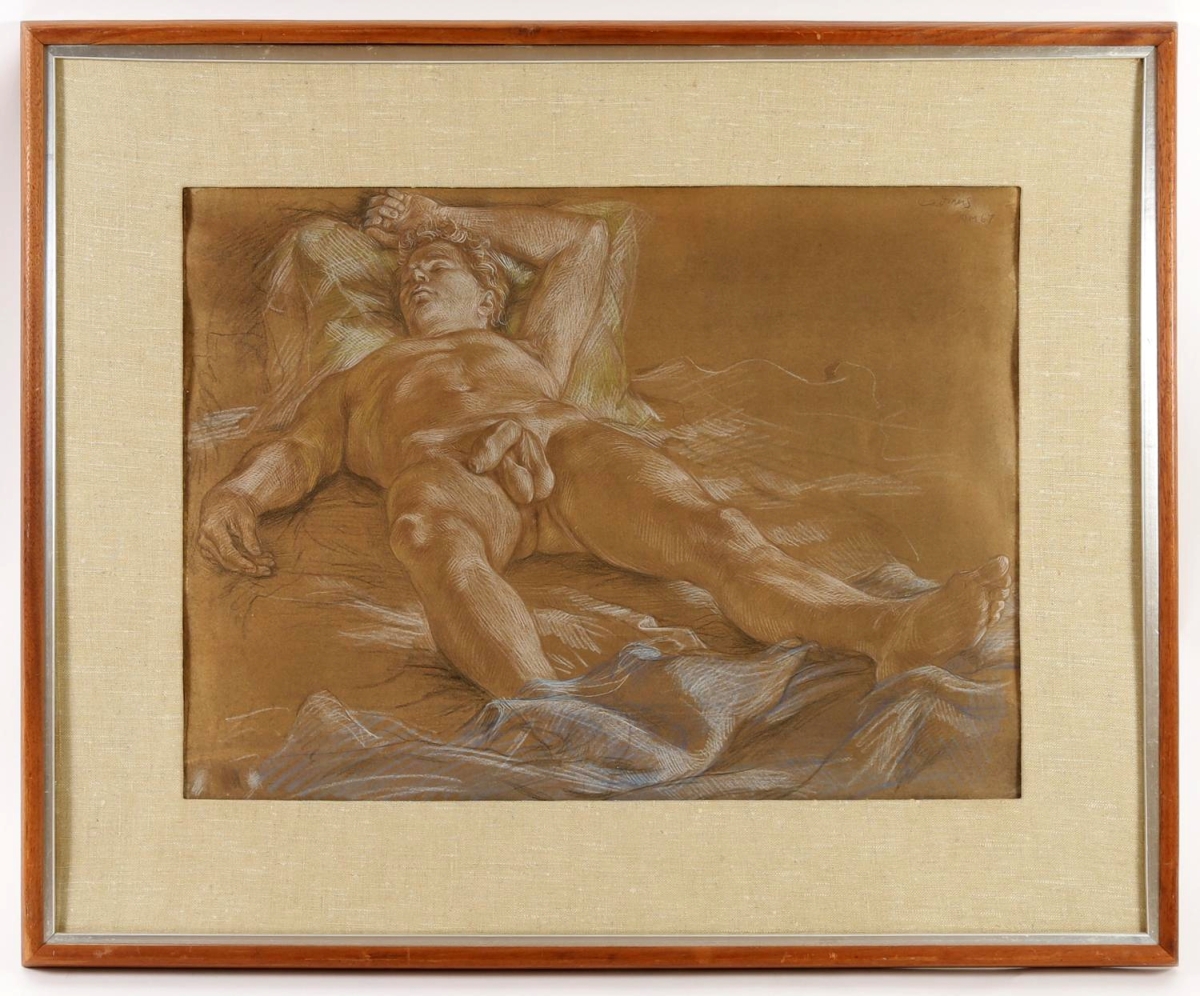
The sale’s top lot was this 1968 crayon on paper by Paul Cadmus, which sold for $42,500. The work measures 17 by 23¼ inches sight. There was no shortage of male nudes in the sale, and auctioneer Lark Mason said the artist’s style creates a parallel between the masters of the Italian Renaissance and the Twentieth Century.
Review by Greg Smith, Catalog Photos Courtesy Lark Mason Associates
NEW YORK CITY – Three major Magic Realist artist estates were funneled into one sale at Lark Mason Associates as the firm offered the estate of singer and actor Jon F. Anderson, the muse and lover of artist Paul Cadmus for 36 years, in the auction titled “Paul Cadmus and His Circle: Property from the Estate of Jon F. Anderson,” which closed May 19.
By descent, the sale included the estates of Cadmus, who left his estate to Anderson when he passed away in 1999, and artists Jared and Margaret Hoening French, who had left their estate to Cadmus when they earlier passed away. It also included works by artists within their circle, including George Platt Lynes, Lincoln Kirstein, Fidelma Cadmus Kirstein and Pavel Tchelitchew.
The sale grossed $1,163,000 and went 98 percent sold.
“We did not lose a beat with the virus,” auctioneer Lark Mason told us. “The sale was a resounding success with the strongest headwinds imaginable. I don’t believe you could have done better than we did. The sale was successful with extraordinarily strong prices.”
The auction felt academic. It was a notable event to those who had an interest in the artists’ lives, and it provided an intimate window therein. We saw works from Cadmus, his father and his sister. Works depicted both Jon Anderson, Cadmus’ lover in late life, and Jared French, his studio-mate, dear friend and lover in earlier life. Cadmus and both Frenches produced images of each other and all were offered in the sale. Photographs, taken in collaboration by the three of them, explore their personal life together and bring into the fold other familiar artists who took part in their circle. Looking into the catalog was a foray into their past, an exhibition in itself.
The run up to sale was anything but normal for the firm.
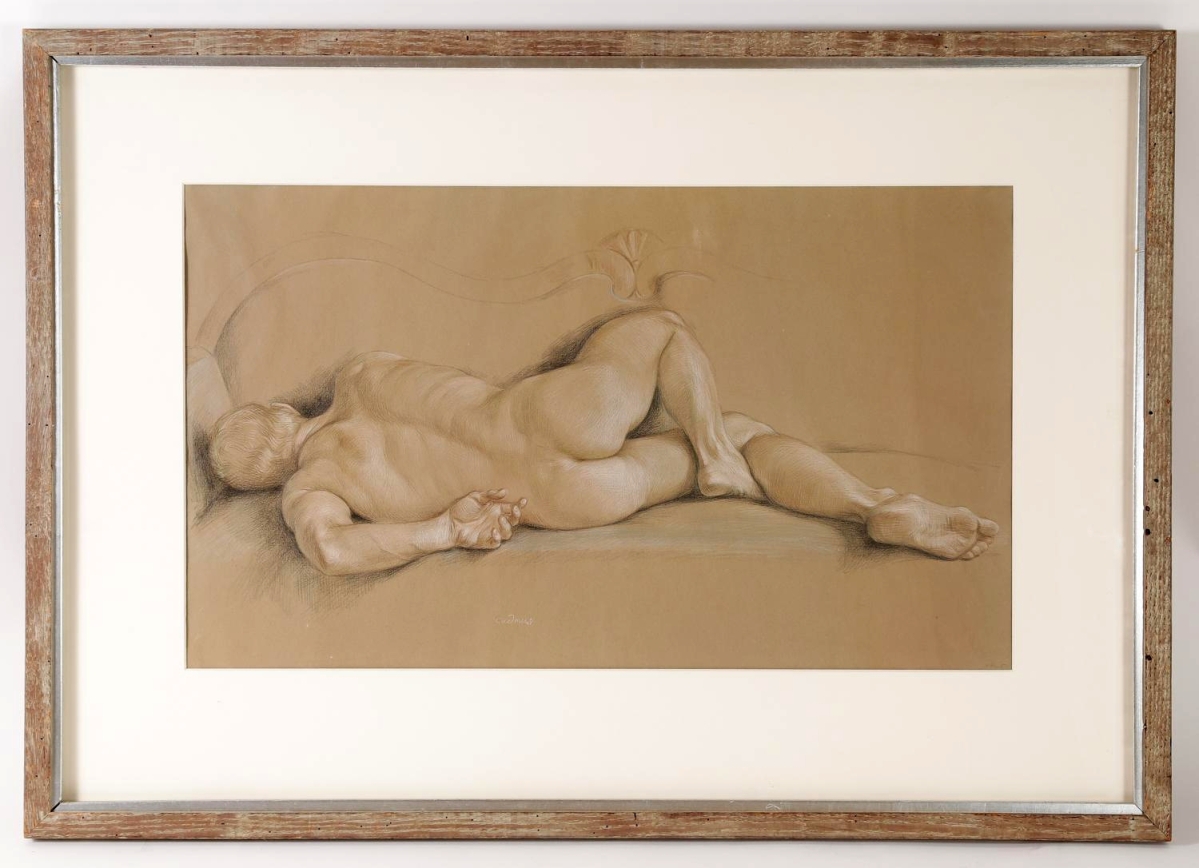
Fetching $41,250 was this reclining male nude in crayon on hand-toned paper by Paul Cadmus, 14½ by 25 inches. The work had extensive exhibition history, having been shown at three museums and two shows at DC Moore Gallery in New York City.
“We were pulling this sale together right at the end of Asia Week, which sort of limped to a close as the virus hit,” Mason said. “We recognized that people wouldn’t have access to our facility, so we immediately started taking a lot of photographs.”
As New York City went into lockdown, Charlene Wang, fine art specialist at Lark Mason Associates, began to take her work home.
“When the Governor announced the New York City stay-at-home order, I had two days to get the work back to my apartment,” Wang said. “I took an Uber…the driver was very unhappy waiting for me. It was a difficult trip by myself. My apartment got filled with these boxes, I had to go through them little by little and then bring them back little by little. Every time I finished with a box, I would bring it back so a coworker could photograph them.”
Because of the nature of the sale, Wang began developing a targeted list of institutions, galleries and collectors that had Cadmus, French or the other related artists within their collections.
That paid off, Wang said, as a number of the 121 total successful buyers were academics or related to institutions in some way.
Two crayon on paper works of sleeping nude males by Paul Cadmus finished at the top of the sale, both executed in the late 1960s. At $42,500 was a 1967 work, 17 by 23¼ inches, featuring a view of a nude male reclining in bed. It had been exhibited in “Paul Cadmus: The Male Nude 1950-1999” at New York City’s DC Moore Gallery in 2002.
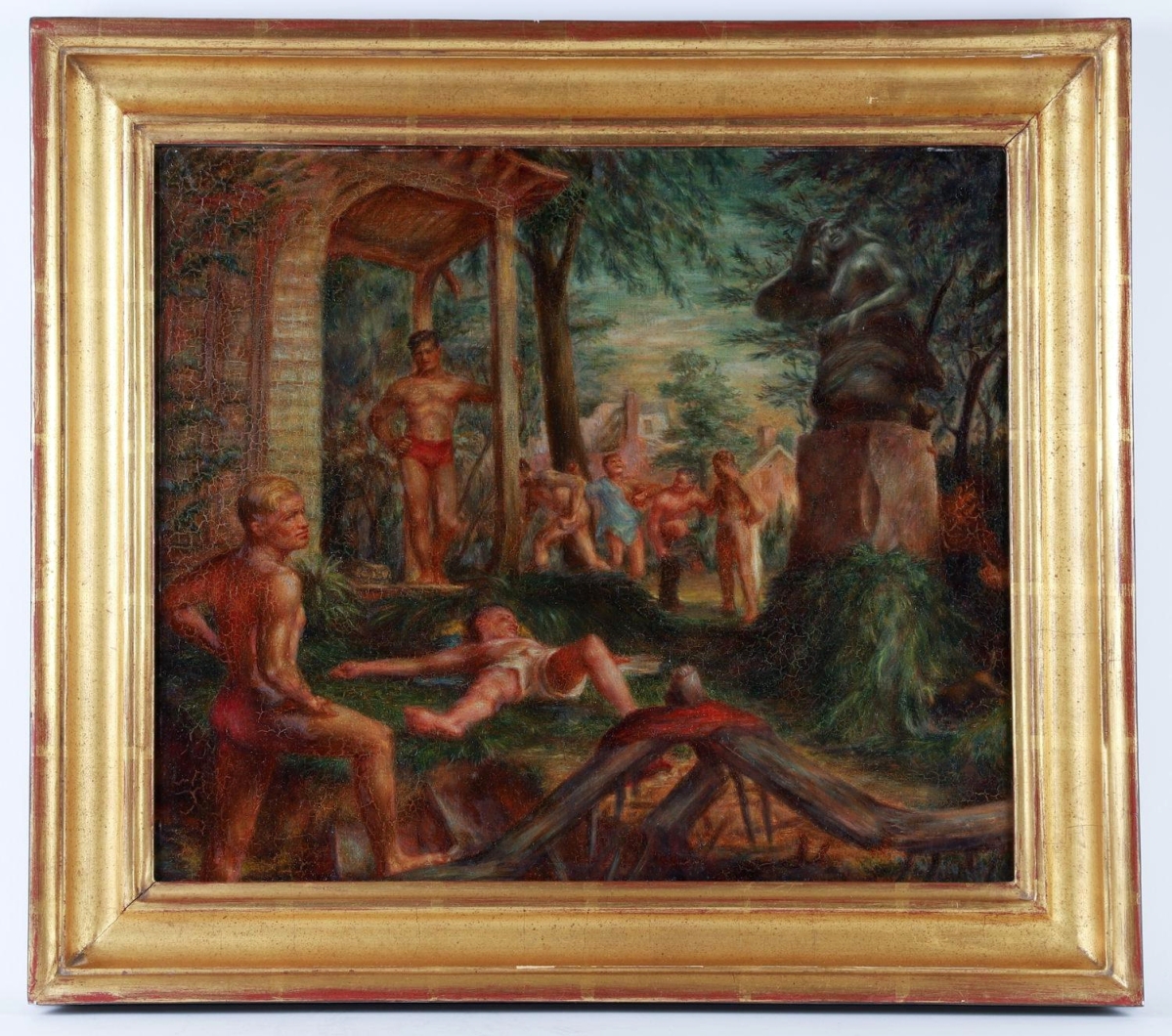
Jared French’s “Male Figures in Garden” proved the artist’s top lot in the sale as it raked in $37,500 above a $6,000 estimate. The oil on panel measures 15¼ by 17½ inches and was executed 1934-1935. Fine art specialist Charlene Wang said it was a good representation of the Magic Realism style the artist was known for.
A 1965 work followed behind at $41,250, featuring a nude male turned towards the back of a sofa as he sleeps. This was Wang’s favorite work in the sale. It measures 14½ by 25 inches and had more extensive exhibition history, including the same show at DC Moore, another at the gallery in 1998, a 1993 exhibition at the Arnot Art Museum, a 1982 exhibition at The Hudson River Museum, and a 1981 exhibition at the Edwin A Ulrich Museum of Art at Wichita State University.
Cadmus’ work is sometimes described as homoerotic, and indeed there was no shortage of male nudes in this sale. The artist was unashamedly gay throughout his life, beginning in the 1920s amid a conservative time in American culture.
Interest in the material was varied according to Mason. He said, “There were people interested in the nudes for a variety of reasons, not just for the drawings, but the relationships found within them, too. He was in Italy for three years and was certainly exposed to the masterworks of Italian artists during the Renaissance and Baroque periods. We had buyers who were interested in that relationship to the Twentieth Century. His classical references are so strong, in my opinion. You get a lot of people who follow that model, it’s a specific kind of training, but he carried it to its full extent, with just enough infusion of the time he was living in to make it distinctive.”
Cadmus’ “The Cecropia Helmet,” a 1927 watercolor and crayon on paper, 17¾ by 23¾ inches sold for $32,500. The sale featured a number of pen, crayon or watercolor studies from the artist that drove home value for bidders, offered in lots with as many as 30 works in them, but also smaller, more affordable lots of 18, 16, 12 and under. Leading at $18,750 was a group of 30 early studies from the 1920s and 1930s that had an estimate of $1,800. A lot of 16 sold for $11,687, a lot of 18 for $11,250 and another lot of 18 for the same price.
Works from Jared French found a leader in “Male Figures in Garden,” a 1934-35 oil on panel that measured 15¼ by 17½ inches. It sold for $37,500 above a $6,000 estimate after 37 bids. The work had been acquired by Cadmus from French during their lifetimes.
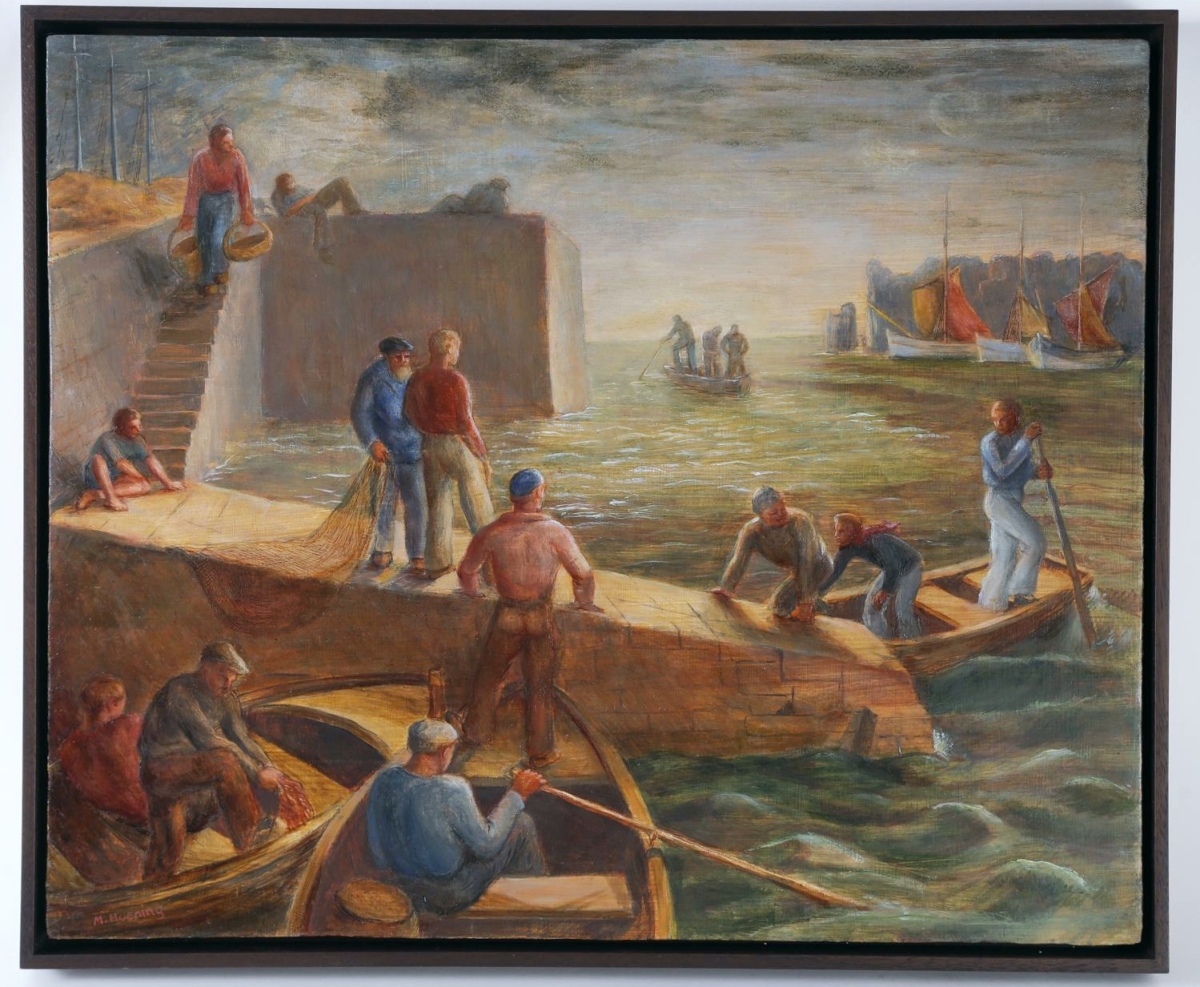
Margaret Hoening French’s top lot was an egg tempera on board titled “Workers At Harbor.” It measures 15¼ by 18½ inches and closed at $24,375 on a $6,000 estimate. Within the sale was the same image in an etching, which closed at a more affordable $250.
“That one was very representative of the Magic Realism style,” Wang said. “You can see that there’s some kind of event going on, but we don’t have any reference. It almost looks historical and there’s a mythical statue on the right. It gives a mysterious feeling.”
Also by French was a tempera on canvas laid on panel, “Three Male Figures,” 48½ by 44 inches, that sold between estimate at $14,375. French’s other top lots were unsigned plaster sculptures executed between 1945-50, which were estimated very conservatively at $400 each. Finishing at $20,625 was a head of a man, 11 inches high; followed by an untitled full-body sculpture of Mel Fellini, 19 inches long, that sold for $19,375; and an 11½-inch-high Archaic-style head that brought $15,625 on 41 bids. There was one bronze by French found within the sale, “The Fat Man,” 21½ inches high, featuring a man in a robe with his belly hanging out, that brought $1,375.
Selling for $24,375 on a $6,000 estimate was Margaret Hoening French’s top work, a 15¼-by-18½-inch egg tempera on board titled “Workers At Harbor.” The work featured a group of fishermen as they pushed off from the wharf in the morning. The sale included preparatory works for this painting, including a nearly identical etching titled “Harbor in Brittany,” which brought $250. Forty-seven lots of works from Margaret Hoening French were represented in the sale, ranging from egg tempera, watercolors, drawings, prints and etchings. It was likely one of the largest releases of her work at auction.
Cadmus and both Frenches formed the collaborative artist group PaJaMa, an acronym of their first names, in the late 1930s. Their photography is in the collection of New York City’s MoMA, and a number of them that appeared in this sale were once handled by DC Moore and Ten Studio Hill. There is no way to tell which of the three was behind the camera at any one time, unless two appeared as subjects in the images. The photographs, 53 lots of them appearing in the sale, represent the relationships of the artists as they created alongside and along with each other. In Glenway Wescott Personally: A Biography by Jerry Rosco, Cadmus is quoted as saying, “After we’d been working most of the day, we’d go out late afternoons and take photographs when the light was best. They were just playthings. We would hand out these little photographs when we went to dinner parties, like playing cards.”
A lot featuring 230 transparencies in color sold for $31,250, leading the group. The majority of them were never published or seen by the public. Many of the scenes featured the circle of artists at the beach in Fire Island or Provincetown. Some of the subjects included Cadmus, George Tooker, Bill Caskey, Todd Bolender, Jared and Margaret French and others. The 52 other lots, ranging in size from one to eight prints in each, sold anywhere from $625 to $5,520, with many of them selling in the $2/3,000 range.
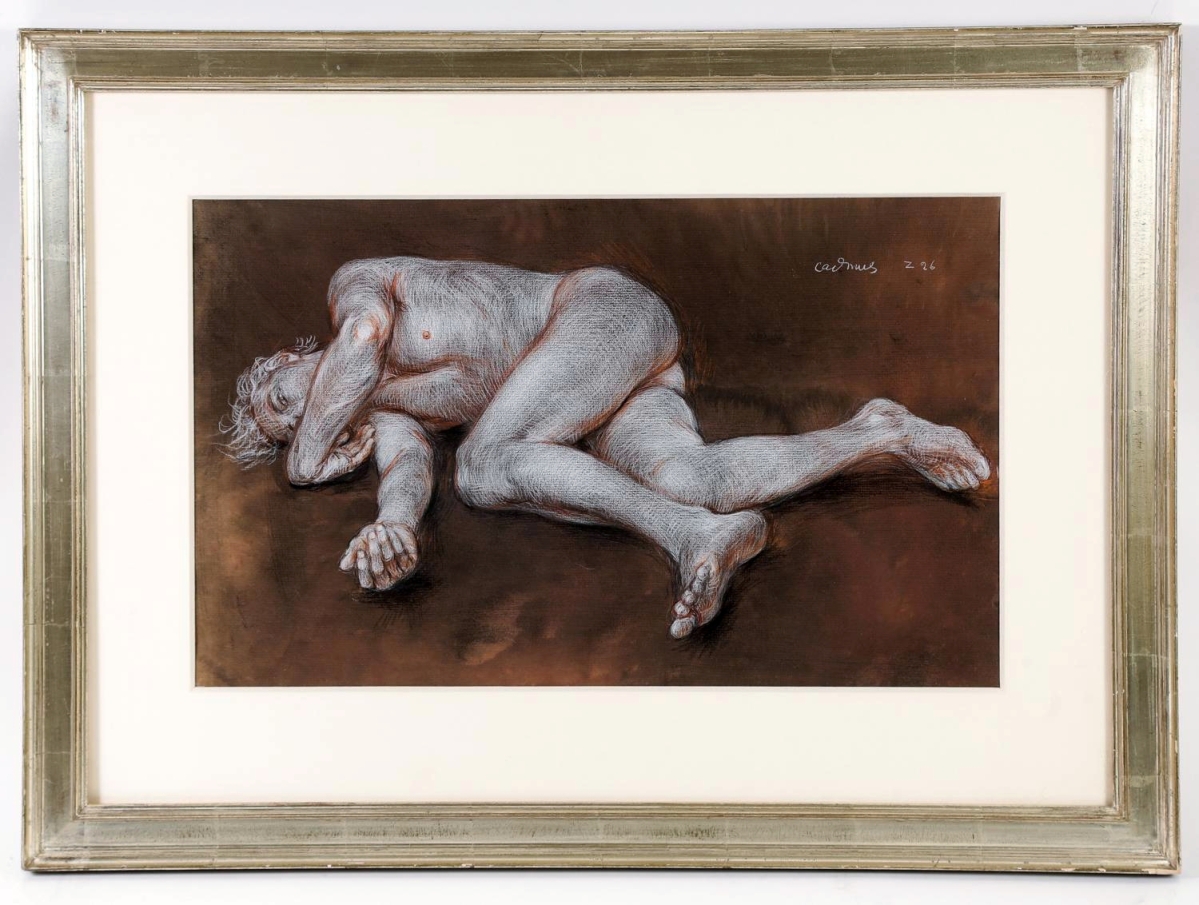
Executed the year before Cadmus passed away, this crayon on hand-toned paper was drawn by the artist in 1998 and sold for $21,250. DC Moore Gallery showed it three times and the Aldrich Museum of Contemporary Art exhibited it in 1999. 14½ by 20- inches.
Photographs by George Platt Lynes found considerable interest. Among them was a group of nine photos of Charles “Tex” Smutney and Charles “Buddy” Stanley, circa 1941, that sold for $15,000. A single print from the photographer featuring Wilbur Wright sold for $10,000 on a $2,000 estimate. It was stamped Vogue studios, where Lynes worked as chief photographer in Hollywood in the late 1940s.
The sale also featured a variety of works from the Cadmus family, including those by Paul’s sister, Fidelma Cadmus Kirstein and their father, Egbert Cadmus. The highest selling work from Fidelma was “Ballet Class,” a colored pencil-on-paper work measuring 6¾ by 8¾ inches that sold for $2,500. Fidelma married impresario Lincoln Kirstein, a co-founder of the New York City ballet and she abandoned art after a tumultuous relationship with him. Landscape scenes from father Egbert Cadmus were affordable, rising to $375 at the highest among the six lots offered.
The entirety of the proceeds from the sale will be donated to Lambda Legal Defense and Education Fund, New York City; Doctors Without Borders, New York City; World Wildlife Fund, Washington, DC; Nature Conservancy, Fairfax, Va.; and PBS Thirteen, New York City.
Lark Mason & Associates is gearing up for another sale that will run late June and into July. It will feature more works from Cadmus as well as his parents.
For additional information, www.larkmasonassociates.com or 212-289-5524.





















